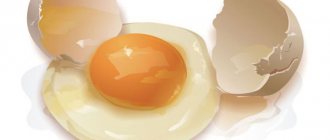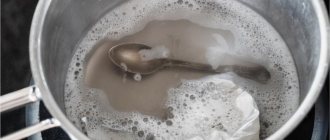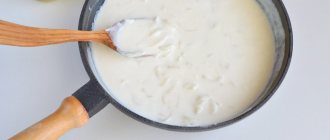How to clean a gas stove?
If carbon deposits and grease cannot be washed off during routine preventative cleaning, you can carry out special cleaning to effectively remove grease and deposits. In this case, you can use tools such as:
- baking soda;
- dishwashing detergent;
- cleanser (eg Selena).
Having chosen the appropriate product, you need to carry out cleaning according to the following instructions:
- Remove all burners.
- Pour the product generously onto the surface of the gas stove and leave it like that for 15 minutes. Particular care must be taken to ensure that the product reaches the areas where the burners were located.
- Rinse a sponge or rag in water and use it to remove the detergent from the surface of the stove.
- If after this, soot particles remain on the stove, then you need to treat them with moistened soda, or use a cleaning agent for these purposes.
- At the end, the stove must be wiped with a dry, clean cloth so that there are no stains left on the surface from the products used.
It also happens that the burners themselves need cleaning. To clean them, immerse them in soapy water for 15 minutes, then rinse with a sponge, rinse with water and dry with a paper towel.
You can view instructions for cleaning a gas stove using 9% vinegar and soda in the following video:
When cleaning a gas stove from carbon deposits and grease, you must not use metal scrapers or hard sponges! Firstly, this will not bring the desired result, and secondly, it will scratch the surface of the slab, worsening its presentation.
What do you need to clean the stove?
In order to bring the surface to perfect condition, you will need:
- The product is gel-like or creamy.
- Dish detergent.
- Baking soda (not suitable for all types of stoves).
- Several sponges, a brush.
Having prepared all the equipment, you can begin. It is recommended to follow this sequence:
- Turn off the gas and electrical ignition power.
- The stove must cool completely after cooking. This will help avoid burns.
- Remove the grate, burners and handles that are soaked in soapy water.
- Remove food residues and crumbs with a dry sponge.
- If acidic chemicals are used for cleaning, be sure to wear gloves. Before using household chemicals, be sure to read the instructions.
How to clean the grate of a gas stove?
When cleaning the grate of a gas stove, you will have to tinker if carbon deposits and grease have formed on it. But before you start cleaning, you should establish what material the grille is made of, because this will determine exactly how to wash it:
Cleaning cast iron grates
Cast iron grates are the most difficult to clean due to the fact that they must be baked. Without this procedure, it is unlikely that it will be possible to eliminate carbon deposits and grease. There are three ways to heat the grate:
- keep on low heat over a gas stove;
- use a blowtorch;
- roast over a fire in a private area.
After calcination, the grate can be easily cleaned in soapy water. Under no circumstances should you remove carbon deposits and grease with a knife or other sharp objects, as there is a possibility of damaging the material, and then the service life of the product will be reduced.
There is a cleaning method using soda paste, which you will learn about in the video:
Cleaning enamelled metal grates
Since these grates have a smooth surface, cleaning them is not difficult, and you can use one of the following methods:
- load the rack into the dishwasher;
- soak the grate in soapy water, then remove dirt with a soft sponge and soda.
Cleaning the steel grate
These grates are easiest to clean using dishwashing detergent:
- The grate should be soaked in soapy water. To ensure that the slab element is completely immersed in water, it is best to do this in a bathtub.
- The floor should be covered with thick oilcloth, on which a grate is laid out and liberally treated with dishwashing detergent.
- The grate should remain in this form overnight.
- In the morning, the grille should be rinsed with water to remove any remaining detergent and dirt.
Video: 5 recipes for cleaning the grate
A special video talks about 5 effective ways to clean the grate of a gas stove. In addition, in the video you can see step by step how to deal with pollution:
Why do streaks, stains and deposits appear on the hob?
This question is not so easy to answer. The fact is that the hob on stoves can be made of different materials. They differ significantly in properties, and therefore in care requirements. Let's take a closer look at the most common options.
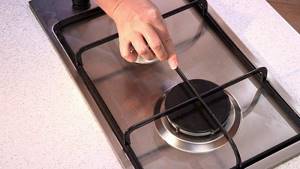
Stainless steel
The main advantage of stainless steel is its resistance to careless maintenance. This material is most often used in budget models of gas stoves. Despite its high stability, it must be periodically washed to remove dirt.
The most common stains that appear on stainless steel are:
- Scale. These are round or oval marks from water droplets. They remain if you do not wipe the surface dry after washing. The cause of stains is carbonic acid salts (carbonates), which are always present in tap water.
- Traces of chlorine . Stainless steel is damaged by products containing chlorine. The result is unaesthetic white stains.
- Rust. As a rule, stainless steel is resistant to the destructive effects of oxygen and moisture due to the addition of chromium. But if you do not clean it from carbon deposits for a long time, the protective capabilities of alloying additives may not be enough, and corrosion begins.
- Nagar. These are leftover food (runaway soup or milk, splashes of fat, flakes of foam from meat broth or coffee). All these residues are partially burned and partially baked into a dense crust with a spongy black or brown surface.
Important! The spongy structure of the soot crust is excellent for the development of bacteria. Therefore, putting off cleaning the stove for a long time is not only wasteful, but also dangerous.
In order not to spoil the stainless steel surface, it is enough to clean it regularly, do not use chlorine-based products and thoroughly wipe the metal dry after cleaning.
Enameled metal
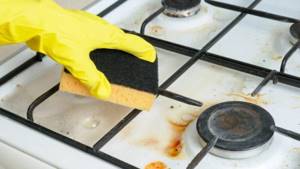
Enamel is another budget-friendly and fairly stain-resistant material. It does not show water stains or fingerprints. But marks appear on the enamel over time. The most common pollutants that cause them are:
- Nagar. As with stainless steel, the cause of carbon deposits is food that has escaped from pots and pans. The longer these residues are not removed, the denser the crust they form.
- Rust. Enamel does not allow oxygen and moisture to pass through. But if cracks and chips appear on its surface, the metal underlying the enamel comes into contact with oxygen, and corrosion begins.
Important! Temperature changes are dangerous for enamel. If you spill cold water on a hot stove, the sudden drop causes uneven expansion of the materials and cracks appear. Falling heavy objects, impacts, etc. are also dangerous.
When cleaning enamel surfaces, do not use metal scourers, brushes, or powders with abrasive particles. They tear off the protective layer of enamel, opening the way for corrosion.
Ceramic hobs
Glass ceramics are sensitive to dirt. If this material is handled incorrectly, it is easy to spoil the appearance of the slab, leaving difficult-to-remove stains on its surface.
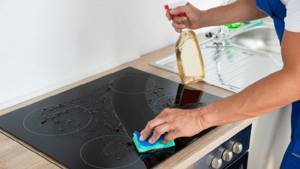
Here are some of the most common varieties:
- Rainbow spots, similar to gasoline stains in a puddle. Such stains are caused by burnt oil. But most often, rainbow marks are prints of dishes made of aluminum or copper alloys.
- Whitish areas, stains. They occur upon contact with aluminum utensils or when ceramics are exposed to dishwashing detergents. To clean the glass-ceramic hob, you must use a separate sponge and do not use it to wash dishes.
- Blue spots. This is a common companion when trying to clean a surface with dishwashing detergent. It is quite difficult to remove such stains.
- Rust. This is a product of the interaction of water escaping from the pans with the metal of the burners. Any water spilled on the panel should be wiped dry immediately, otherwise rust stains will inevitably appear.
In addition, areas on which pans are placed may change color during cooking. Due to abrasion, these areas of the panel become lighter than unaffected areas. Special products for the care of glass ceramics will help restore the color.
How and with what to wash a glass-ceramic stove
Glass ceramics is a reliable and practical material, but it is extremely sensitive and fragile. Therefore, when cleaning, you should follow the following recommendations:
- Do not start cleaning the surface of the stove while it has not yet cooled down. Firstly, you can get burns, and secondly, such actions can contribute to the formation of cracks in the glass ceramics.
- When washing such slabs, do not use abrasive agents, as they will scratch the surface of the slab.
- When choosing a cleaning product, you need to make sure that it bears the inscription “For glass ceramics.” And if you don’t have time to look for such a product, you can use dishwashing detergent or soda.
- If you need to deal with light stains in the form of coffee, splashes of oil or compote, you can use soda and a scraper.
- For difficult stains in the form of “escaped” milk, special chemicals for glass ceramics are selected. In this case, trying to use something else is a waste of time and effort.
- If sugar stains have formed on the stove, they must be dissolved in water before cleaning. In this situation, water can cope with even the thickest layer of caramel.
Cleaning with a scraper
If the carbon deposits are particularly resistant, you can clean them using a special scraper for glass-ceramic stoves:
- The stove must be disconnected from the power supply.
- Check to see if it has completely cooled down.
- Apply detergent to the surface of the stove.
- Use a scraper and a sponge soaked in warm water.
- Wipe the surface of the stove dry.
Anti-scale soda
If you use soda to wash glass ceramics, it is best to dilute it with water, since this will have a more gentle effect on the surface of the stove. Despite the fact that soda is similar in consistency to powder, it is not capable of scratching the surface of glass ceramics. It is best to leave the soda diluted in water on the stove for 10-20 minutes, and then remove it with a damp sponge.
Anti-grease melamine sponge
Many people underestimate the power of this sponge, but it sometimes copes with grease even better than detergents. This sponge is very easy to use:
- It should be soaked under cold water and squeezed out.
- Start rubbing the surface of the stove.
These sponges literally wipe away all the dirt from glass ceramics like an eraser.
In the case of a glass-ceramic hob, remember that it will be much easier to clean it if it is done immediately after the stove has completely cooled down to avoid burns. The “fresh” the stain, the easier it is to deal with.
How to clean a stainless steel stove?
Regardless of the type of surface, be it a mirror or matte finish, you must remember that stainless steel is susceptible to scratches. Therefore, you should not use cleaning agents and detergents that contain abrasive particles, as well as iron brushes and other similar tools. After all, dirt that has penetrated into a scratched surface is very difficult to remove, and in general, with this approach, the slab will lose its “presentation” very quickly. But then how to wash such a stove?
Popular folk methods for cleaning stainless steel plates
| Means | How to use |
| Soda | Dilute baking soda with water to a paste-like consistency and apply the mixture to the stove. Wait 15-20 minutes and then wipe it clean with a soft cloth. |
| Activated carbon | Excellent for removing dirt such as burnt milk. Several tablets must be ground into powder and sprinkled on the stove, avoiding getting into the nozzles. Spray a little water, leave for ten minutes and rinse. |
| Lemon juice or vinegar | You just need to dip a sponge in the product and wipe the stove. Then you need to walk over the surface with a clean damp cloth. This method is good because nothing needs to be diluted or crushed. But there are disadvantages: the method only deals with fresh and non-dried/non-burnt stains. In addition, if you use vinegar, the smell will linger in the kitchen for a long time, especially if there is no hood. |
We suggest you read How to remove epoxy resin from metal
Interesting: Glass-ceramic stove - choice, care, tips. 7 cleaning tips
To save yourself the hassle, you can purchase a special cleaning product. Ideally, wash a stainless steel stove well with creamy or liquid cleaners and soft sponges: they will not damage the finish. Manufacturers produce detergents that will help get rid of scale, grease, and carbon deposits.
Useful: Top 10 cookstove manufacturers: choosing your leader
Video: Cleaning the stove with folk remedies
To ensure that the stove remains clean and always looks like “new”, you can also use folk remedies. In many cases, it is even more effective, not to mention the fact that it is more economical and safer than chemicals. What exactly can be used for these purposes and how to do it can be seen in the video.
The method of cleaning the stove and the means for these purposes are always selected depending on what material the stove is made of. Only in this way can you ensure cleanliness in the kitchen, as well as obtain a guarantee that the stove will work properly. It is best to take care of the stove regularly, then there will be no difficulties in cleaning it.
A stove is an indispensable household appliance for the kitchen. Unfortunately, it is not always possible to wash the surface of the stove after each cooking, and dirty stains remain on it. How to clean the stove from grease using folk remedies?
How to effectively clean the stove from grease and carbon deposits at home?
Cleanliness in the apartment begins with the kitchen. After all, family life is always concentrated in this room. After cooking, traces of soot and greasy splashes remain on the stove. And the family hearth should always be clean. Therefore, the task of every housewife is to maintain cleanliness in the kitchen. How to quickly clean the stove from grease and carbon deposits at home? Every housewife asks herself this question when it comes to cleaning.
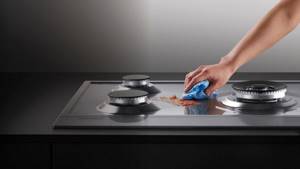
Stove care rules
You can spend a lot of time fighting old grease and deposits. But if you take a few care rules into account, you can clean your stove in no time.
Before cleaning the stove, remove the handles, burner and grid. Soak heavy and dried dirt by mixing hot water with detergent and pouring the solution over the dirty areas. Leave the surface to soak for half an hour.
Use only proven products that dissolve fat well. Wear rubber gloves to protect your hands.
If you have a steam cleaner, it will be great for cleaning your stovetop. With its help, you can easily whiten grates, handles and all hard-to-reach places on the surface of the stove.
It is better to wipe down the stove immediately after cooking. It will take you five minutes, but you will get rid of the dirt effortlessly.
To avoid having to clean your gas stove at all, cover it with foil before cooking. After you remove the foil, you will see that the stove remains absolutely clean.
How to clean a stainless steel stove?
Before washing a stainless steel stove, follow these recommendations to avoid irreversible consequences:
- Remove all objects from the stove and nearby surfaces so that they do not interfere with the washing process and the cleaning agent does not get on them.
- Pay attention to the technical features of your stove: gas or electric.
- Turn off the gas or make sure the stove is not on.
- Determine whether burners and controls can be removed. If they can be removed, carefully remove them from the socket.
- To avoid allergic reactions to the skin of your hands, use personal protective equipment: rubber gloves.
- Carefully read the instructions for the product you choose.
- If the product has a specific or strong odor, work in a well-ventilated area.
- Before using any product, test it on an inconspicuous area of the stove.
- Increase the concentration of any detergent or cleaning agent you choose gradually, alternating with rinsing with water.
- Do not mix chemicals to avoid the formation of toxic gases and unexpected stains.
Important! The stove is very convenient for cleaning, as it has a large horizontal surface. But if you also have other utensils - pots, saucepans, stainless steel frying pans, then it is better to use more suitable methods for these items. Moreover, they come into direct contact with food.
Read the article links from our website:
- How to clean stainless steel?
- How to clean the outside of a stainless steel kettle?
Next, proceed in such a way that the question of what and how to clean a gas or electric stainless steel stove is resolved quickly:
- Use a soft cloth or sponge to gently wipe away any crumbs from the surface.
- Wet a sponge generously in warm water and dampen the cooking surface to loosen any stubborn dirt.
- Remove most of the dirt using collecting movements in one direction.
- Apply the cleaning agent to the sponge and work the slab, paying attention to problem areas.
- Rinse off any remaining foam with a clean, damp cloth.
- Spray polish over the surface.
- Wipe dry with a paper towel (napkin).
Important! To prevent streaks from forming on the hob, wipe it with point-to-point movements.
Gas stove
The coating of the gas stove is enamel, and it is susceptible to scratches. Therefore, no metal brushes or abrasives are suitable for cleaning. Use foam sponges and gentle products that are found in every home:
- Ammonia. It removes grease from surfaces well and carefully, but the disadvantage of this method is its pungent odor. When you use it, open the windows or turn on the hood, then the smell will quickly go away.
- Soap solution. Mix 300 ml of water, a little shavings of laundry soap and a tablespoon of ammonia. Apply to the problem area. You can also soak the grate in this solution. Leave for 20 minutes. Rinse with water.
- Cleaning solution. Mix 300 ml of warm water, 15 g of powder, 30 g of soda, 10 g of glue. Pour everything into a spray bottle and apply to contaminated areas. After half an hour, wipe with a clean sponge and rinse with water.
- Soda. Dilute it with water and apply to contaminated areas of the slab. Leave for about half an hour. Rinse everything off with water and wipe with a sponge.
You can use a melamine sponge to clean the stove - an organic substance that looks like a regular sponge. It will remove grease and carbon deposits without any problems, but after one cleaning it is no longer suitable for use.
Remove the removable handles and soak, like the grill, in a soapy solution. You can pour a bleach solution over everything, it will wash away almost any grease. One downside is the strong smell.
Cleaning the cast iron grate of a kitchen gas stove
You can still clean the stove, but cast iron grates are the main problem, on which most of the time and effort is spent. The main method of cleaning a cast iron grate is annealing.
This is done in the following ways:
- in the oven at maximum heat;
- over lit burners;
- blowtorch (dangerous method, not recommended for use at home).
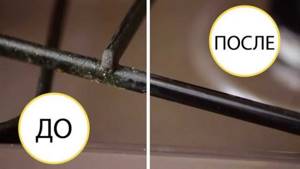
It is not recommended to scrape fat from the surface, as it will be damaged. Calcination is a rather dangerous method, so use folk remedies.
- Mustard. Wet the grate and apply dry mustard powder to the entire surface. The substance is caustic and eats away fat well. Leave for 10 minutes. Rub with a brush and rinse under running warm water. Dry.
- Soda-vinegar mixture . Mix soda and vinegar in such proportions to obtain a pasty consistency. Spread the mixture evenly over the entire surface of the grill, rub with a brush and rinse with water.
- Sand. Everyone remembers how to clean a plate or cutlery from grease in nature. Of course, sand. It absorbs fat perfectly. You will need fine sand, which needs to be warmed up a little. Distribute it over the entire surface of the grill. Using a metal sponge, scrub the dirty area thoroughly.
- Soap solution. Pour warm water into a basin, add regular detergent, a couple of tablespoons of vinegar and a few tablespoons of soda. Place the grids into this solution. Leave for several hours. Remove the grate and rub thoroughly with a sponge soaked in detergent.
- Boiling is a simple and effective method. You will need a large saucepan, pour 5 liters of water into it, add 3 tbsp. l. soda ash, a crushed piece of laundry soap and a chopped apple. The mixture, at first glance, will seem strange. But soda ash and soap have good cleaning properties, and an apple will add shine to the product thanks to malic acid. Boiling time depends on the degree of contamination.
After the grate is cleaned of grease, be sure to dry it thoroughly. Since fat sticks very quickly to wet surfaces.
You can tidy up the burners in the same way as the grate. Basically, they are wiped with soapy water.
Electric stove
An electric stove is easier to clean than a gas stove, since its coating is ceramic or glass, and they are more resistant than enamel. Most importantly, do not forget to unplug the stove from the outlet before starting cleaning. Allow the hob to cool completely and begin working.
Treat the surface with a special solution or regular detergent, then wipe with a sponge. For burnt grease, use a scraper designed for this purpose, which can be purchased with the cleaner. It is designed specifically for smooth surfaces.
You can also use olive oil or vinegar. Apply them to the greasy stain, then wipe with a rag.
Cleaning the oven
You can clean your oven at home using simple methods. Dilute laundry soap in hot water and rub the entire oven with the resulting solution. Pour the rest into a baking tray and turn on the oven for half an hour. When the metal has cooled, wipe everything with a washcloth.
Use baking powder for dough. Apply it to contaminated areas, sprinkle with water and leave for a while. The fat will form lumps and you can easily remove it with a sponge.
Use salt to clean. Sprinkle it on the inside of the oven and turn on the appliance for a while until it turns brown. Then sweep away the salt and wipe the oven.
You can solve the problem of annoying grease and stains with the help of special chemical compounds and folk remedies. Choose a method for yourself that will help you clean the stove, grate and oven without difficulty and large material costs.
The gas stove requires cleaning after each cooking. But this does not always work out, because it is usually used throughout the day. Old stains that have formed over a long period of time can be difficult to deal with. Even with careful care, unsightly dark spots or scratches may appear. But you should not use harmful household chemicals in the kitchen. It is better to learn how to clean a gas stove using home remedies.
Sequencing
When cleaning the stove, you should follow a certain sequence of work:
- first of all, you need to disconnect the device from the gas and/or electricity supply;
- Having removed the grate, you can immediately soak it in a warm soapy solution;
- The burners and handles are also removed, if possible; they are easier to clean from stubborn dirt separately;
- Wash the surface of the stove with a cloth, which will remove small debris and some fresh stains from it.
After the preparatory steps, you can begin the main work.
How to clean a stainless steel stove
Stainless steel plate requires careful care
There is a clear algorithm of actions that allows you to thoroughly clean the slab and maintain its original appearance. To implement it you need:
- remove all utensils from the stove surface;
- disconnect the device from the power source and shut off the gas in the pipe;
- disassemble the upper tier, remove the burners from the base and the handles from the control panel (if possible);
- put on rubber gloves;
- remove all small crumbs and unstable stains from the stove with a soft sponge;
- soak stubborn stains by placing wet rags soaked in detergent on them;
- open the windows and ventilate the room if the chosen product has a persistent chemical odor;
- remove softened dirt with a hard sponge using stroke-like movements;
- process the slab in a circular motion, pressing firmly on the work surface;
- wash off any remaining detergent;
- apply stainless steel polish to the stove;
- Wipe all parts dry with a clean soft cloth.
We suggest you read: How to clean a burnt stainless steel pan - burnt jam
1 2 3 4 5 6
To prevent stains from remaining on the stainless steel plate, you need to wipe the metal parts with point-to-point pressure at the final stage.
How to clean the slab covering
- The hob is easily cleaned with a mixture of vinegar and soda:
- moisten the coating with diluted acetic acid;
- pour soda on top of it;
- wait for a few minutes until the intense reaction ends;
- Rub the surface with a soft sponge, then rinse it with water and dry; you will find that this is an excellent cleanser.
There are many simple recipes that will tell you how to clean a gas stove at home:
- dissolve soap (half a teaspoon) in two glasses of water and add the same amount of baking soda; The mixture is best used hot;
- apply it to the coating and leave for a short time;
- wipe with a sponge, then wash, then wipe dry.
This mixture is even more effective when table vinegar is added to it. It can be successfully replaced with citric acid, the result will be the same.
- A mixture of mustard powder and soda has excellent cleansing properties. After filling with water, it must be applied to the surface of the slab. After 15-20 minutes you can wipe it with a cloth, rinse and dry. The same mixture can be used as a pen cleaner. This mixture for cleaning a gas stove can be stored in a sealed container and used as needed.
- You can fill the stove with a solution of table salt overnight. Take a tablespoon for two glasses of water. During this time, the salt will soften the fat, and in the morning you just need to wipe the stove with a wet cloth.
- Ammonia works great on stains on the stove. After moistening a soft sponge in it, you need to treat the contaminated areas, and after a while wipe them with a damp cloth and then with a dry one. When working with ammonia, you must follow safety precautions, since it evaporates easily, and ammonia vapors have a pungent odor and can burn the nasopharynx. Cleaning the gas stove should be carried out with the windows open and in the absence of children and animals in the room.
- If there are burnt milk stains left on the stove, they can be quickly removed using activated carbon, which has excellent sorbing properties. After sprinkling the stain with crushed tablets, fill the entire mass with water. After ten minutes, the stain will become wet. Next, wash the surface without any extra effort.
- Coffee grounds find effective use as a stovetop cleaner. You just need to apply it to contaminated surfaces, lightly rubbing with a soft cloth, and rinse off after two to three minutes. The panel will sparkle like new.
When cleaning the hob surface of the stove, you should remember some rules:
- Do not use abrasive cleaning agents, as they can damage the enamel, after which it will corrode even faster;
- Cleaning soda must be diluted in water;
- You cannot use metal jaws or scrapers;
- if the stove has a stainless steel coating, it is better to wash it after each cooking - then there will be no stains on it;
- Harsh cleaning agents and aggressive liquids are also not suitable for metal surfaces - they need careful care;
- After cleaning, wipe the glass-ceramic surface well with ammonia solution so that there are no streaks left on it.
When deciding what you can use to clean your gas stove, you should use these tips.
It is best to wipe down the oven after each use. But if there are long-standing stains, then the following cleaning agent can be used:
- heat the water by dissolving the laundry soap shavings in it;
- wipe the inside of the oven with liquid;
- Pour the prepared mixture into a baking tray or other heat-resistant dish, place it in the oven and heat for half an hour.
During this time, the fat will melt, and it will be enough to rinse the oven with warm soapy water.
If it is not heavily contaminated with grease, it can be washed with a solution of soda, acetic or citric acid. After moistening the oven walls, apply a mixture of baking soda and any acid solution to them and leave for about 30 minutes. During this time, the fat will dissolve and you can rinse the walls with warm, clean water.
Another effective and affordable remedy is a mixture of salt and soda with water in equal proportions. Apply the mixture to the inner walls of the oven and leave overnight. In the morning, you can rinse the oven with water and wipe dry.
How to clean a gas stove from the smell of burning? Regular table salt will help here:
- pour a thick layer of salt onto a baking sheet;
- place it in the oven and heat it for about 15-20 minutes;
- the salt will absorb the smell, and then the oven should be rinsed with warm water.
How to clean a stainless steel hob
The metal surface requires care, since even small drops of water leave stains after drying. And during the cooking process, food particles and drops of fat get onto the panel. Therefore, the kitchen unit must be cleaned regularly. The cleaning technology depends on the type of panel: gas or electric. Each of them has design features.
The gas hob needs not only washing the surface, but also cleaning the grilles. They constantly accumulate fumes, dust and grease.
You can clean it all up like this:
- select a large baking tray, fill it with water and place a wire rack in it;
- put it in the oven and heat it as high as possible;
- after the water boils, wait 30-40 minutes and turn off the gas - all the accumulated fat will come off the rods on its own;
- After the grate has cooled, wipe it with a cloth or hard sponge.
Sand, soda or other abrasives can also help clean the grate, but in this case it must first be soaked in warm water and soapy water for 1.5 hours.
Another feature of the gas panel is the presence of burners and nozzles. The burners must be completely cool before washing. They are removed and soaked for 30 minutes in a solution of liquid soap and hot water, taken in a ratio of 1:10. After this, each part is wiped with a hard sponge. The gas channels are cleaned with an old toothbrush and wiped with a slightly damp cloth.
The stainless steel electric hob is cleaned so as not to touch the cast iron pancakes with moisture. It is unacceptable to treat them with water - this will lead to discoloration and the appearance of rust spots. Heating the burner will help remove dirt: food residues will char, and after cooling they can be removed with a dry sponge.
We suggest you read: Washing kitchen towels with mustard - removing stains and whitening
Before washing the panel, it must be disconnected from the gas or power supply. Remove dishes and other items from the surface. If the stove is gas, then remove the grate from it.
Attention. There is a huge selection of special products for cleaning stainless steel surfaces, so read the ingredients carefully before purchasing.
The hob requires careful and careful handling. The following products are good for cleaning:
- “Shumanit” is a liquid product made in Israel. Spray the solution on the surface and leave for a few seconds, then wipe with a damp cloth and rinse with water.
- “Shine of Steel” is a thick cream with a soft abrasive base. Effective for removing limescale and grease stains, polishes the surface. Apply a small amount of the composition to the stove and spread it over the entire area with a sponge. Leave for 4-5 minutes and remove the cream with a sponge, rinse with clean water.
- “SIF” – spray the product onto the dirty area and after 3-4 minutes wipe with a damp cloth. Then treat the slab with a sponge soaked in clean water. The solution can be used daily to prevent the formation of limescale. Can also be used to clean oven grease.
In addition to special household chemicals, products that can be found in every home are also suitable for cleaning. For example, baking soda will save you from old stubborn stains. First, clean the stove with regular liquid dish soap.
Then spread about half a glass of baking soda evenly over the hob and add a little water to dissolve the crystals. After this, leave the resulting mixture for 1.5 hours. Using a soft sponge, effortlessly wipe the surface and remove the product.
After this, wash and dry the surface.
The activated carbon method also cleans stainless steel panels well. Coal (10-12 tablets) is crushed into powder, sprinkled thickly on the areas where carbon deposits have appeared, and a little warm water is added. The pulp is left for 15 minutes and then removed with a soft sponge or cloth.
Vinegar or lemon juice does a good job. To do this, soak a rag in a small amount of table vinegar or the juice of one lemon. Rub problem areas for 2-3 minutes, then rinse with water and wipe with a dry cloth.
The main stages of cleaning a stainless steel hob are as follows:
- Remove the grate (if we are talking about a gas device). It should be cooled down. Place it in the sink and wash off the surface layer of dirt. Any abrasive detergent will do for this.
- Spray or spread detergent over the surface of the hob with a sponge, paying special attention to areas with stubborn stains. You should not scrub them; it is better to leave the cleaning solution for a while.
- Effortlessly wash the surface with light movements. If stains still remain, it is better to reapply the cleaner and wait a little. After this, remove the stubborn dirt and preparation with a sponge, treat it several times with a sponge soaked in water.
- Wipe dry with a soft cloth or towel, polish and assemble: replace the burners and grate.
Cleaning the handles
The handles of a gas stove are often shaped, with elements that are difficult to reach, and their attachment points also become dirty. It is convenient if they are collapsible. In this case, they can be removed and soaked in one of the household cleaners. They soak quickly and are easy to clean. If there are long-standing stains, the parts can be washed by boiling in a weak solution of acetic acid, and then rinsed with clean water and dried.
In the case of non-removable handles, you will have to use improvised means: a toothbrush, cotton swabs, toothpicks. With their help, you can clean the parts with soda or a mixture of soda and acetic acid, and after a while rinse the area with clean water. All these simple compositions will always be at hand and will help you clean your gas stove at home.
Cleaning the burners
Home remedies can also be used to effectively remove grease from burners. You can soak them in hot soapy water and then wash them with a sponge. It is better to clean hard-to-reach places with a cotton swab or toothpick. After rinsing them with clean water, you need to wipe them dry.
The burners can be cleaned in another way - fill them with water and acetic acid (in equal parts), wait about five minutes. Then you need to rinse them well and dry them.
The cleaning method depends on the material from which the grille is made:
- those covered with enamel are not afraid of water and acids, the pile is quite hard, they are lighter in weight and look aesthetically pleasing;
- cast iron is the most durable and strong, but when cleaning it is also better not to get carried away with aggressive agents;
- Grates made of steel can be cleaned with fine-grained abrasives and aggressive agents.
Tips for cleaning the grill are as follows.
- A dry cast iron grate is best cleaned by heating over a fire. When pieces of soot begin to fall off, you can clean it with a metal sponge. It should be remembered that a hot cast iron grate cannot be washed.
- Gratings coated with enamel or made of stainless steel should be soaked in a hot soapy solution with the addition of vinegar, soda and mustard and left in it for several hours. During this time, the grate will become wet and can be cleaned with an iron brush.
- One of the cleaning methods is a good folk remedy - dry mustard. By rubbing the grate with it, you can quickly remove dirt and grease. Then you need to rinse it with warm water.
- You can use heated sand or sand with laundry soap to clean the grate.
- If grease has accumulated on the grate for many years, then it should be soaked overnight in a hot soapy solution, adding ammonia or acetic acid. During the night, the fatty deposits will become soaked, and the grate can be cleaned with a wire brush or sponge.
When washing grates, it is important to follow some rules:
- Cast iron grates cannot be soaked in water or soap solutions - under the influence of water their strength decreases and cracks may appear;
- Strong impact on grilles of any type with metal brushes can lead to their damage;
- Do not immerse hot grates in cold water - the temperature difference may cause cracks;
- The white cast iron from which Chinese grates are made is very fragile - you should not use sand to clean it.
There are different ways to clean the stove from grease and other contaminants. But if you wipe away any stains that form in a timely manner, there will be little need for “general cleaning,” and the gas stove will be able to please the eye with sparkling cleanliness.
Every housewife very often puzzles over how to clean the gas stove from grease. Each of them dreams of finding a product that will ideally clean out all the accumulated fat on the surface. Fortunately, there are many ways and means to remove fat and even plaque. Let's look at them in our article.
To clean a gas oven, it is recommended to use cleaning products that contain abrasive substances to protect the surface of the stove from damage. It is advisable to wash the stove with a soft sponge with the addition of soda or liquid detergents. We also recommend that you read the previous article, where we looked at the rules for caring for gas and glass-ceramic stoves - this will help avoid the appearance of grease on the surface.
To easily remove dried stains from the stove, you can use baking soda.
, after which you need to wipe the surface with a solution of ammonia in a 1:1 ratio with water.
You can also use regular laundry soap.
You need to rub the soap and add a little warm water to it. Using a soft sponge, apply this solution to the surface of the stove and leave for 15 minutes. After all contaminants have been removed, they need to be washed off with warm water and the surface wiped with a clean cloth.
You can also clean the stove from grease using lemon juice.
You need to take a small lemon and squeeze the juice out of it directly onto the dirt so that it covers the entire greasy area. If you don’t have lemon on hand, you can take citric acid diluted with water or apple cider vinegar. As for citric acid, in principle, this is also a very good remedy.
A solution of ammonia and vinegar also has an excellent effect on fatty areas of the stove surface and removes them easily and quickly. This solution leaves no odor or residue.
How to clean the stove from grease so that it shines like new?
Let's look at some tips:
Before you start cleaning the stove, it must be freed from the burners and gas handles. They need to be removed and placed in a basin of hot water, adding detergent to remove grease. Next, you need to wipe the entire surface of the stove with the same product. But you must remember that you should not wipe it off from grease, but simply moisten it thoroughly with the product and leave it to dry for a while.
After a while, the fat will become soaked, after which it can be easily removed with a sponge and warm water. To ensure that the burners and handles are well washed, you can, if desired, rub them with an old toothbrush. Places that are difficult to reach can be cleaned with a cotton swab soaked in ammonia.
The grate is a part of a gas oven that is very difficult to clean.
If you have a dishwasher in your kitchen, it will generally be easy to clean the grate. To do this, you need to clean it in a machine in hot water a couple of times a week.
If you do not have a dishwasher, you will need to place it in a bowl of hot water with a degreaser before cleaning it. If this is not the case, then you can use baking soda or vinegar solution.
The grate needs to be left in this solution overnight, and in the morning you need to clean it with a wire brush. If the grate cannot be wiped off, you need to repeat the entire procedure again.
When you have finally washed your cookware, wipe its surface, burners, handles, and grate dry with a clean cloth. This procedure must be done so that drops of fat do not stick to its surface again. To make your stove last longer, its surface can be covered with special foil.
Remember, under no circumstances use hard or metal scourers to clean your gas stove. Be careful when using detergents that contain abrasive substances; they can damage the surface of your gas stove.
Remember that the stove needs to be wiped down at the slightest contamination, and general cleaning must be done once a week.
Any housewife sooner or later faces the problem of a dirty kitchen stove and she has to decide how to clean the stove from old grease and carbon deposits. Indeed, it is almost impossible to cook food without getting the cooktop dirty. Water always splashes out of pots, splashes of fat fly out of frying pans, pieces of food fall onto the stove and burn. To clean your kitchen appliance, you can buy chemicals or use traditional methods.
Do not start cleaning the surface of the stove until it has cooled completely. This can cause burns. And if your oven is gas, the hot burners can damage the countertops you place them on. Always protect your hands with rubber gloves.
The main stages of washing a stainless steel stove

Let me make a small disclaimer. The idea of writing an article about how to wash a stainless steel stove came to me after returning home from a multi-day business trip, during which my younger generation and my husband not only heated lunches and dinners they had prepared for future use, but also cooked dumplings and even buckwheat porridge themselves.
In fact, it was the buckwheat porridge that had thoroughly dried onto the stove that caused my family the greatest difficulty in cleaning the stove. And she waited for me.
Remove the grate from the stove
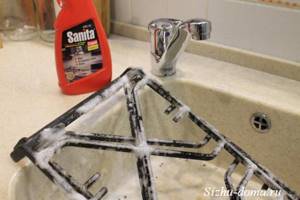
To speed up the washing process, you can apply any dishwashing liquid or kitchen detergent to the grate. As a rule, the grate for gas stoves is made of a very dense and wear-resistant material (mainly cast iron), so the grate can be washed with any abrasive agent.
While our grate is “soaking”, let’s work on the stove.
Treat the stove with detergent
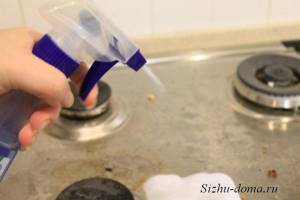
Under no circumstances should you rub the surface!
Scraping burnt or dried-on food from a stainless steel cooktop can damage the surface, leaving unsightly scratches.
It is best to coat the entire surface of the stove with detergent and leave for a few minutes.
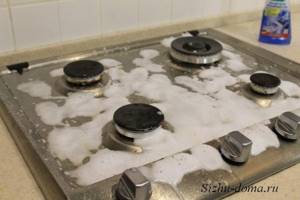
You need to wash the stove grate both on top, the surface on which food is cooked, and on the bottom - pieces of burnt food also remain there.
For quickness and convenience, you can take a dishwashing sponge, apply a cleaning agent to the abrasive (harder) surface, wrap the sponge around individual sections of the grill, and using rubbing movements, thoroughly rinse all parts of the grill. After which the grille is rinsed and wiped with a soft cloth.
Cleaning the stove
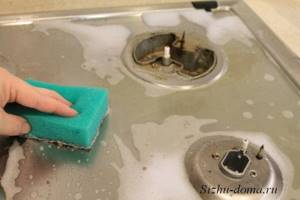
If the stove is in very bad condition and food residues are difficult to remove from the surface of the stove, you can spray a little more detergent, focusing on the most difficult areas, and wait a little longer.
After this, remove any remaining food and foam with a sponge, rinse the sponge, and wipe again until the stove is clean.
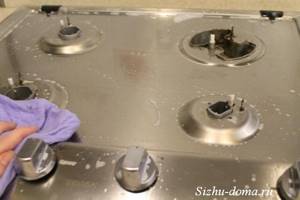
At this stage, the cloth must be rinsed several times, completely removing any remaining detergent.
Thoroughly rinsing the cloth when washing helps avoid possible stains on the stove.
Wipe dry and collect
We wipe our stainless steel stove with a soft, dry cloth or kitchen towel, “rubbing” it until it shines.
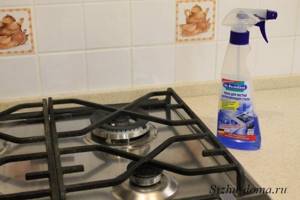
After this, we assemble the stove, installing both the gas heads and the grate in place.
It took me about twenty minutes to wash the stainless steel stove, even in such neglected condition. At the same time, I was in no hurry and did not rub the surface of the stove “until I lost my pulse.” It was enough to simply apply stainless steel cleaning foam to the stove and then wash it off!
Yes, I use the same product to wash faucets in the kitchen and bathroom, and other household appliances made of stainless steel.
What product are you using?
Sometimes it is better to see how it is done once than to read it several times. I suggest watching a video of how to wash a stainless steel gas stove in practice.
In fact, in order to wash a stainless steel stove, only 15 minutes is enough, no more.
Share on social media networks:
Stainless steel plates are very popular today, so the question often arises among housewives: how to wash a stainless steel stove? This material is famous primarily for its increased resistance to corrosion compared to conventional steel, and besides, a plate made from it looks beautiful and stylish. However, there are a number of inconveniences, which consist in the fact that a metal surface requires more painstaking care and the use of special products, since the incorrect selection of cleaning agents will be reflected on the surface in the form of scratches and stains that cannot be removed in any way. Another feature of a stainless surface is that it requires a more thorough approach to the final stage of cleaning - polishing. Are you wondering how to clean your cooktop without streaks? You will learn about all the features of caring for a stainless steel stove from this article.
How to clean a dirty enamel stove
Enameled stoves were the most common some 20-30 years ago. They can have different enamel colors, are quite durable, easy to use and easy to operate. The oven can be washed with detergents, cleaning agents, and soda. Use various types of sponges and rags, steel wool.
Rules for washing the stove itself:
- It is recommended to pour the surface with detergent or cleaning powder diluted with water or a soda solution and leave for up to 20 minutes to soak the fat;
- After the time has passed, wash everything with a sponge, carefully paying attention to particularly dirty areas near burners or electric pancakes.
How to clean a stainless steel stove
The stainless metal coating looks nicer than regular painted enamel. This material is stronger, which means the oven will be more resistant to any mechanical action. The only drawback in its operation is the stains and stains remaining on the surface. That is, when washing it you need to handle it extremely delicately. This oven cannot be washed in a circular motion. And after cleaning, you should wipe it well, preferably with a cotton cloth. If you still cannot avoid stains, a slice of lemon will help. You need to wipe the steel surface with it and dry it thoroughly with a soft cloth.
The washing rules for this type of stove are the same as in the case of enameled stoves.
If your oven is gas, then in addition to the surface itself, you need to pay special attention to the burners, grate and handles.
Rules for washing burners.
Even if, at first glance, it is not clear that the burners are dirty, a large amount of grease and soot still collects on them. In order to get rid of unpleasant accumulations, it is recommended to put them in a soapy solution for a while, then rinse them in water, wipe them dry and put them back in place.
Rules for washing grates.
Depending on the material the grates are made of, there are some differences in how they are cleaned.
- Cast iron grates cannot be cleaned with water. In order to remove accumulated fumes from them, they need to be heated, for example, over gas or a fire. It is not recommended to use knives to scrape off carbon deposits from a cast iron grate, as this can damage the material from which it is made.
- The enamel structure can be soaked in soapy water or washed in the dishwasher. Their smooth surface is easy and quick to clean, but, as in the case of cast iron, you should not use a knife to avoid scratches and damage.
- Stainless steel grates generally wash well with cleaning agents and detergents, but for a better effect, they are soaked for a couple of hours (or better yet overnight) in water with chemical compounds, then rinsed and dried.
The following folk remedies will help clean the grate from carbon deposits and grease:
- A solution of vinegar and soda 2:1;
- Dry mustard left on steel and enamel elements for a couple of hours;
- Warm sand, which should be thoroughly rubbed onto the grate.
After washing the grates, you should wipe them well before using them again, because grease particles stick very quickly to wet materials.
Hand washing rules.
It is more convenient to wash the handles, which are removable. You can do the same with them as with the burners, putting the fat in a soap solution to soak. A mixture of lemon juice with soda or vinegar with soda, ammonia diluted 1:1 with water, or regular laundry detergent will also help. Handles that are not removable can be cleaned with a toothbrush; toothpicks or ear sticks will help in especially hard-to-reach places.
